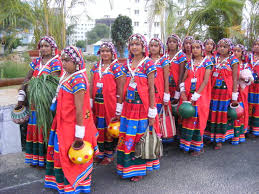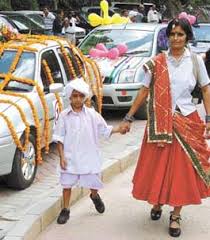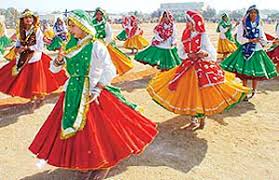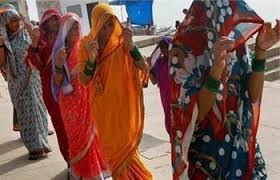source(google.com.pk)
Traditional Dresses Of Haryana Biography
Haryana is one of the States of India popular for its colorful and vibrant traditional clothes. We can reflect the simplicity as well as enthusiasm of the people of this state through their dressing style. With the womenfolk of this state dressed in colorful clothes, we can safely say that they are affectionate towards color. ‘Daaman’, ‘Kurti’ and ‘Chunder’ complete the traditional dress worn by the womenfolk of this State.
‘Daaman’ is the long ankle length colorful skirt and the ‘Kurti’ is a waist length blouse or shirt usually in light colors. The ‘Chunder’ is the long colored cloth which is worn by the women as a ‘chudni’. The main attraction of the chunder is that its borders are beautifully stitched with shiny laces and is used by the women to cover their head to show respect to others. The end part of the ‘chunder’ are drawn in the front, similar to the ‘pallu’ of saree. With these colorful clothes, the ornaments worn by them adds more charm to their overall appearance.
The ornaments worn by the women of this State are usually made of gold and silver. The main items include a necklace (haar), heavy bangles (hansli) made of silver, long hanging string of gold mohars or silver rupees (jhalra ) and earrings (Karanphul and bujni). The women also wear a large nose-ring called nath. Other ornaments which are worn by them are anklet (Kari), and Chhailkara neori and pati which are all worn on the legs. Along with these traditional ornaments, some new types are also worn by them. They are tops (balian) for the ears, ‘churis’ for the wrists and ‘pandels’ for the neck.
The men of this State generally wear ‘Dhoti’, the wrap around cloth, tucked in between the legs with a white-coloured kurta worn atop it. The traditional headgear for men is ‘Pagri’, which is now worn mainly by the old villagers. In the State of Haryana, all-white attire is a status symbol for men.
The traditional dressing style of the people of Haryana is simple yet very beautiful and colorful. Women wear a ‘Damaan’, an ankle length skirt, ‘Kurti‘ a waist length shirt and ‘Chunder’ which is a long piece of cloth that the women use to cover their head. The men wear a 'Dhoti', which is a wrapped piece of cloth around the legs and a ‘Kurta,’ a long shirt on top. They also wear a 'Pagri', a type of turban as headgear. Traditionally, the men’s cloths will be white.
Like Punjab, the costumes of Haryana are also very vibrant and colorful. The simplicity of the people of Haryana and their spirited enthusiasm for life is visible in their way of dressing up. The women of this state have a special affection towads colors. The basic traditional dress of Haryani women is the Damaan, Kurti and Chunder. The Daaman is the ankle length, flairy long skirt, available in bright colors. Kurti is a waist length shirt or blouse, usually in light colours. Chunder is the actually the long, coloured piece of cloth like the chudni. The highlight of the chunder is usually the shiny laces all anong the border and is used to cover the head and is drawn in the front like the ‘pallav’ of the saree.
Dressing styles and patterns of the costume of the Haryana people reflects the nature and culture of people of Haryana. Through their dressing colors and traditional attire, you can observe Haryana people's enthusiasm and simplicity to wards their life. They wear very simple and sober type of cloths. It contains turban, dhoti, shirt and their traditional style pair of shoes. Haryana men always take a chaddar or blanket over the shoulder as a wrapper. The Haryani people who wear the turban are different specific castes of people such as Rajput, Jat, Brahman or Bania and Ahir. As per difference between the communities, you will also get to see difference in the attires of the women of Haryana state. The women who belongs to the Jat community, those women wears full dress which called as thel, it contain shirt, ghaggri and orhani which is printed , the ghaggri which they wear should fall below the foreleg. The women who are of Ahir community, you can easily recognize through their recognizable petticoat or lehenga, orhani and angia it is like tight fitting blouse. The orhani which Ahir women wear is broader in size as compare to the Jat women's orhani. Because Ahir women also do work out side the house, so that time their broader orhni is helpful to cover the abdomen. This Ahir orhni is generally in yellow and red color and decorated by using the fringes and bosses, with a inside covering fall. There is similarity between the dress of Ahir women and Rajput women. Rajput women's orhni might be used of plain white and it also has fringe in silver color, but there is one major difference that it does not have fall. For the Aggarwal and Brahman women saris and dhotis are very much favorite dressing attires. The women of Haryana state, needs 3 various costumes for different situation. 1st is for field, 2nd is for grindstone and the 3rd costume is while drawing the water out of the well. Village women do various types of tasks in a day, that’s why they need different costumes. As per the Haryani peoples thinking pattern, they decide the status of the family from the cloths wore by the family members.
On the occasion of marriage, as per the Hindu tradition, people of Haryana state also wear very much colorful attires. In Haryana, the marriage party usually colors the duppatas and the bridegroom side colors the turban. In the Haryana's female dress you will get to observe the skirt or kamiz, ghagra or salwar, overcloth or duppata and pajamas all these different parts of single attire in various colors. Within the educated families, women would like to wear saris made of various colors. In Haryana, dresses of women contain more styles of variety than the dresses of male. These different attires also represent the different community and caste of Haryani women. The women of Chamar community can be identified by their red attire and woman of Gujjar community through their blue color cloths. The cloths of Gujjar woman decorated by the round shaped glass. Girls who are unmarried wear the gaudy cloths, because of that they can avoid the unsafe attention of the people. People of Haryana state are very much attracted towards the jewellery and ornaments. Their very general jewellery is like ear rings of small size silver or gold, gold chains, necklaces in Jat community known as Kathla and Bania people called it as mala and many more jewellery items they worn on the important occasions like festival, celebration and marriages, but the thing is that rich people only wear this ornaments because it is very much costly.










Traditional Dresses Of Haryana Biography
Haryana is one of the States of India popular for its colorful and vibrant traditional clothes. We can reflect the simplicity as well as enthusiasm of the people of this state through their dressing style. With the womenfolk of this state dressed in colorful clothes, we can safely say that they are affectionate towards color. ‘Daaman’, ‘Kurti’ and ‘Chunder’ complete the traditional dress worn by the womenfolk of this State.
‘Daaman’ is the long ankle length colorful skirt and the ‘Kurti’ is a waist length blouse or shirt usually in light colors. The ‘Chunder’ is the long colored cloth which is worn by the women as a ‘chudni’. The main attraction of the chunder is that its borders are beautifully stitched with shiny laces and is used by the women to cover their head to show respect to others. The end part of the ‘chunder’ are drawn in the front, similar to the ‘pallu’ of saree. With these colorful clothes, the ornaments worn by them adds more charm to their overall appearance.
The ornaments worn by the women of this State are usually made of gold and silver. The main items include a necklace (haar), heavy bangles (hansli) made of silver, long hanging string of gold mohars or silver rupees (jhalra ) and earrings (Karanphul and bujni). The women also wear a large nose-ring called nath. Other ornaments which are worn by them are anklet (Kari), and Chhailkara neori and pati which are all worn on the legs. Along with these traditional ornaments, some new types are also worn by them. They are tops (balian) for the ears, ‘churis’ for the wrists and ‘pandels’ for the neck.
The men of this State generally wear ‘Dhoti’, the wrap around cloth, tucked in between the legs with a white-coloured kurta worn atop it. The traditional headgear for men is ‘Pagri’, which is now worn mainly by the old villagers. In the State of Haryana, all-white attire is a status symbol for men.
The traditional dressing style of the people of Haryana is simple yet very beautiful and colorful. Women wear a ‘Damaan’, an ankle length skirt, ‘Kurti‘ a waist length shirt and ‘Chunder’ which is a long piece of cloth that the women use to cover their head. The men wear a 'Dhoti', which is a wrapped piece of cloth around the legs and a ‘Kurta,’ a long shirt on top. They also wear a 'Pagri', a type of turban as headgear. Traditionally, the men’s cloths will be white.
Like Punjab, the costumes of Haryana are also very vibrant and colorful. The simplicity of the people of Haryana and their spirited enthusiasm for life is visible in their way of dressing up. The women of this state have a special affection towads colors. The basic traditional dress of Haryani women is the Damaan, Kurti and Chunder. The Daaman is the ankle length, flairy long skirt, available in bright colors. Kurti is a waist length shirt or blouse, usually in light colours. Chunder is the actually the long, coloured piece of cloth like the chudni. The highlight of the chunder is usually the shiny laces all anong the border and is used to cover the head and is drawn in the front like the ‘pallav’ of the saree.
Dressing styles and patterns of the costume of the Haryana people reflects the nature and culture of people of Haryana. Through their dressing colors and traditional attire, you can observe Haryana people's enthusiasm and simplicity to wards their life. They wear very simple and sober type of cloths. It contains turban, dhoti, shirt and their traditional style pair of shoes. Haryana men always take a chaddar or blanket over the shoulder as a wrapper. The Haryani people who wear the turban are different specific castes of people such as Rajput, Jat, Brahman or Bania and Ahir. As per difference between the communities, you will also get to see difference in the attires of the women of Haryana state. The women who belongs to the Jat community, those women wears full dress which called as thel, it contain shirt, ghaggri and orhani which is printed , the ghaggri which they wear should fall below the foreleg. The women who are of Ahir community, you can easily recognize through their recognizable petticoat or lehenga, orhani and angia it is like tight fitting blouse. The orhani which Ahir women wear is broader in size as compare to the Jat women's orhani. Because Ahir women also do work out side the house, so that time their broader orhni is helpful to cover the abdomen. This Ahir orhni is generally in yellow and red color and decorated by using the fringes and bosses, with a inside covering fall. There is similarity between the dress of Ahir women and Rajput women. Rajput women's orhni might be used of plain white and it also has fringe in silver color, but there is one major difference that it does not have fall. For the Aggarwal and Brahman women saris and dhotis are very much favorite dressing attires. The women of Haryana state, needs 3 various costumes for different situation. 1st is for field, 2nd is for grindstone and the 3rd costume is while drawing the water out of the well. Village women do various types of tasks in a day, that’s why they need different costumes. As per the Haryani peoples thinking pattern, they decide the status of the family from the cloths wore by the family members.
On the occasion of marriage, as per the Hindu tradition, people of Haryana state also wear very much colorful attires. In Haryana, the marriage party usually colors the duppatas and the bridegroom side colors the turban. In the Haryana's female dress you will get to observe the skirt or kamiz, ghagra or salwar, overcloth or duppata and pajamas all these different parts of single attire in various colors. Within the educated families, women would like to wear saris made of various colors. In Haryana, dresses of women contain more styles of variety than the dresses of male. These different attires also represent the different community and caste of Haryani women. The women of Chamar community can be identified by their red attire and woman of Gujjar community through their blue color cloths. The cloths of Gujjar woman decorated by the round shaped glass. Girls who are unmarried wear the gaudy cloths, because of that they can avoid the unsafe attention of the people. People of Haryana state are very much attracted towards the jewellery and ornaments. Their very general jewellery is like ear rings of small size silver or gold, gold chains, necklaces in Jat community known as Kathla and Bania people called it as mala and many more jewellery items they worn on the important occasions like festival, celebration and marriages, but the thing is that rich people only wear this ornaments because it is very much costly.
Traditional Dresses Of Haryana
Traditional Dresses Of Haryana
Traditional Dresses Of Haryana
Traditional Dresses Of Haryana
Traditional Dresses Of Haryana
Traditional Dresses Of Haryana
Traditional Dresses Of Haryana
Traditional Dresses Of Haryana
Traditional Dresses Of Haryana
Traditional Dresses Of Haryana
Traditional Dresses Of Haryana